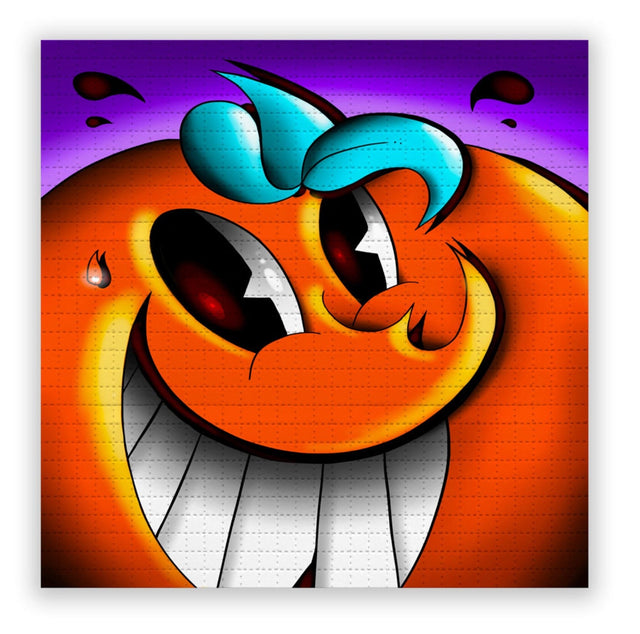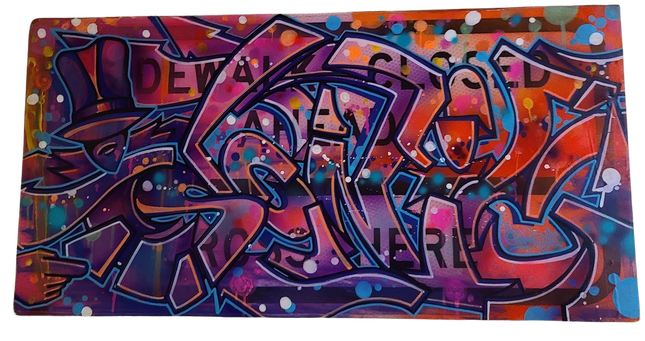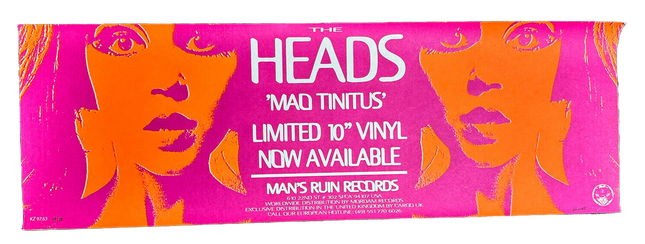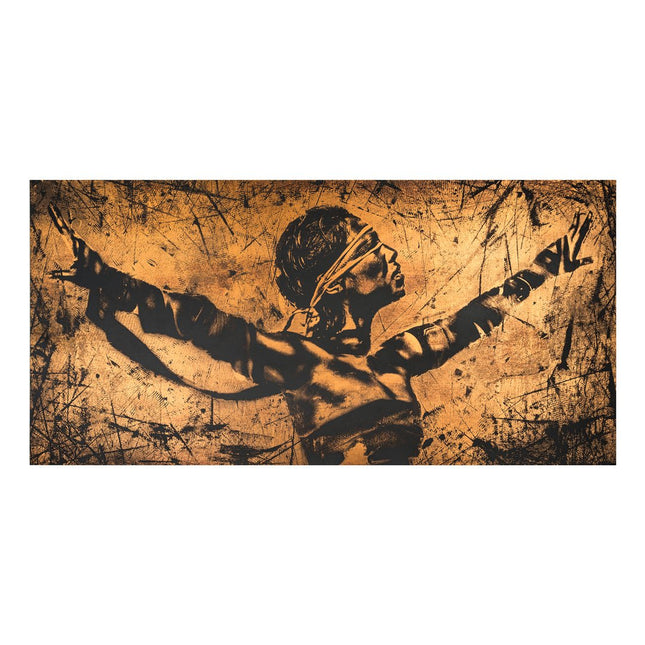
Orange

Sonic Bad Sidewalk Closed Wood Original Mixed Media Street Sign Painting by Sonic Bad
Sidewalk Closed- Wood Original Mixed Media Graffiti Artist Modern Pop Art on Real Street Sign by Sonic Bad. 2018 Signed Original Spray Paint & Mixed Media on Wooden New York City NYC Sidewalk Closed Vintage Sign Artwork Size 21.5x11.5 The Artistic Alchemy of Sonic Bad: Reimagining Public Notices Sonic Bad's 'Sidewalk Closed - Wood' is an exemplary showcase of modern pop art manifested through the lens of street sensibilities and graffiti culture. Created in 2018, this signed original piece is a vibrant declaration of the transformative power inherent in street pop art and graffiti artwork. The fusion of spray paint and mixed media on a wooden canvas that once served as a New York City sidewalk sign encapsulates the artist's penchant for repurposing the functional into the visually extraordinary. Technique and Symbolism in Sonic Bad's Work The artwork, measuring 21.5x11.5 inches, is a testament to Sonic Bad's mastery over mixed media. The piece harmoniously integrates the textures of wood with the fluidity of spray paint, achieving a layered effect that adds depth and complexity to the composition. The choice of a 'Sidewalk Closed' sign is significant; it takes an object that signifies obstruction and transforms it into a portal of creative expression, thus inviting reflection on the role of public space and the rules that govern it. Sonic Bad's approach to the sign is subversive yet playful, disrupting its original intent and engaging viewers in a dialogue about the accessibility of art and public communication. The vibrant color palette and intricate design work serve to capture the gaze and provoke thought, a hallmark of effective street pop art. The way the letterforms and characters are interwoven with the sign's warning embodies a kind of artistic alchemy, turning the mundane into the magical. Impact and Reception of Sonic Bad's Street Sign Artwork The 'Sidewalk Closed - Wood' piece by Sonic Bad does not simply occupy space; it commands attention and interaction. Its existence in a gallery or a private collection continues to challenge perceptions of street art's place within the art world hierarchy. Sonic Bad's work is celebrated for its unabashed embrace of street art aesthetics while simultaneously pushing the boundaries of what such art can communicate and how it is perceived. Sonic Bad, an artist who remains an enigmatic figure in the graffiti art scene, utilizes anonymity as a tool, allowing the work to speak for itself. The artist's contributions to street pop art are measured by the vibrancy of the pieces left in public view and the conversations they ignite. The influence of such work extends beyond the streets, infiltrating popular culture and challenging traditional art's status quo. Sonic Bad's Legacy in Street Pop Art Sonic Bad's 'Sidewalk Closed - Wood' is not merely a piece of reclaimed street furniture but a microcosm of street art's potential to redefine the aesthetics of urban living. This work stands as a cultural artifact, a piece of New York City's story told through the eyes of a street artist. Sonic Bad's legacy is enshrined in every color splash and line twist, a testament to the enduring allure and social commentary of street pop art and graffiti artwork. The legacy of artists like Sonic Bad is often measured by the endurance of their work in the public imagination and their ability to inspire future generations of artists. By turning a sidewalk sign into a canvas, Sonic Bad has not only altered the sign's trajectory but also contributed to the narrative of street art as a form of modern pop art. This piece will continue to be a point of reference for discussions about the interplay between public space and artistic freedom, embodying the spirit of street art that refuses to be sidelined.
$2,000.00

Frank Kozik Heads Mao Tinitus 10" Vinyl Album Release Silkscreen Print by Frank Kozik
Heads Mao Tinitus 10" Vinyl Album Release Silkscreen Print by Frank Kozik Hand-Pulled on Fine Art Paper Limited Edition Pop Street Art Artwork. 1997 Signed by Kozik & Numbered Limited Edition of 100 Artwork Size 33.5x11.5 Silkscreen Print Band Gig Poster by Frank Kozik The 1997 release of "Mad Tinnitus" by The Heads marks a creative collaboration between the band and renowned artist Frank Kozik, who brought his distinctive style to the limited edition silkscreen print for the album's 10" vinyl release. Known for his ability to encapsulate the spirit of the music scene within his art, Kozik's design for "Mad Tinnitus" celebrates pop art through the lens of street aesthetics, a testament to the synergy between auditory and visual experiences in the cultural landscape. Measuring 33.5x11.5 inches, the artwork stands out with its vivid color scheme and striking imagery, characteristic of Kozik's bold design ethos. The piece features a dual portrait that commands attention, utilizing a contrast that pops against the print's background. This limited edition silkscreen, hand-pulled on fine art paper, was signed and numbered by Kozik, with only 100 copies made, adding to its exclusivity and appeal among collectors and music enthusiasts alike. Kozik's artwork for The Heads' release is a dialogue between music and graphic art, a physical embodiment of the album's energy and the era's artistic tendencies. It's a slice of the 90s music scene captured in print, echoing the band's raw sound with Kozik's basic visual punch. As a piece of pop and street art, it bridges the gap between two realms traditionally seen as separate. The artwork has a magnetic pull, reminiscent of the gritty yet vibrant walls of urban landscapes, where music often serves as a backdrop to the visuals. Collectors of Kozik's work appreciate not only the visual impact of his art but also the stories they tell and the histories they encapsulate. This print, serving as a band gig poster as well, is a narrative piece, conveying a moment in time when "Mad Tinnitus" became a visual experience as much as an auditory one. Such pieces have carved out their niche in the art world, celebrated for their crossover appeal and for capturing the essence of a particular musical epoch.
$421.00

Eddie Colla Faith Copper Metal HPM Etched Print by Eddie Colla
Faith- Copper Limited Edition Hand-Embellished Acid-Etched Metal Print on Steel by Eddie Colla Graffiti Street Artist Modern Pop Art. 2020 Signed & Numbered Limited Edition of 40 Artwork Size 23.5x11.5 "Each piece in the exhibit was to represent each line of text, 'Faith' being the third line. Oddly enough, 1xRUN and I began production of this edition well before the current state of affairs. The world is funny sometimes. I can't think of a more appropriate time to release a piece about faith." "Faith means a lot of different things to a lot of different people. I personally am not a religious person at all, so this is not about religion. It’s really about the things that we strongly believe in, which guide us in times when the outcome is in no way guaranteed." – Eddie Colla
$406.00




